1990s
World record for most severed hands reattached in one week
As far as I can tell, their claim to this record remains unchallenged.
Palm Beach Post - Nov 1, 1997
Posted By: Alex - Sun May 26, 2019 -
Comments (1)
Category: World Records, Surgery, 1990s
Bad-Breath Evaluator
Not as bad a job as being a gasmask tester. But still, pretty bad.
San Francisco Examiner - Oct 21, 1997
Posted By: Alex - Tue May 21, 2019 -
Comments (0)
Category: Jobs and Occupations, 1990s
Man sues God
Donald Drusky, of McKeesport, Pa. (which happens to be my mother’s hometown) specifically wanted God “to grant him the guitar-playing skills of famous guitarists, along with resurrecting his mother and his pet pigeon.”Suing God, and perhaps even winning, would seem to be the easy part. Collecting payment is what’s hard.

Asbury Park Press - Mar 16, 1999
Posted By: Alex - Sat May 18, 2019 -
Comments (2)
Category: Religion, Lawsuits, 1990s
Janet Downes, Sologamy Pioneer
We’ve posted before about sologamy, which is the term for marrying yourself. Back in 2017, we described it as a growing trend. But apparently the woman who gets credit for pioneering this practice was Janet Downes of Nebraska who, on June 27, 1998, married herself. She recited her vows in front of a mirror.
Downes died in 2007. But in a post over at realdivasride.com, she recollected about her self-wedding and explained how it came to be:
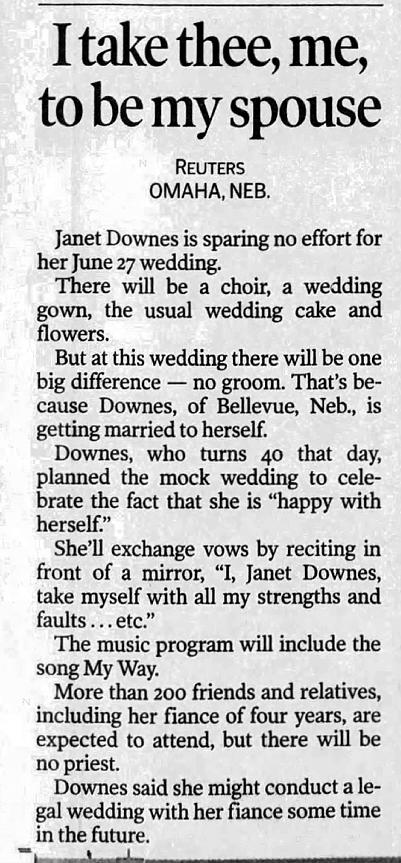
Calgary Herald - June 18, 1998
Posted By: Alex - Wed May 08, 2019 -
Comments (0)
Category: Marriage, 1990s, Weddings
Art Disposal Service, #2
A few months ago I posted about an art disposal service created in the 1960s by artist John Manno. Turns out that art disposal services are a recurring theme in the art world, because another one was created in the 1990s by Thomas O’Day who (evidently unaware of the earlier one) billed it as the world’s first.Some details from the LA Times (Feb 3, 1995):
“I didn’t want to show the work,” he said. “The idea of burying it allowed the work to still be around and go through a process. The first law of conservation is: ‘The more things change, the more they stay the same.’”
That burial would eventually lead O’Day to establish the “Waste to Energy to Waste Project: The World’s First Art Disposal Service.” Any artist wishing to dispose of art can employ his service, which uses a variety of means, including burial and explosives, to eradicate the work or transform it into another form.”
More details (including a video) at O'Day's site.

Some of his other artistic endeavors similarly involved the destruction of art, such as Flambé, “a 1990 performance in which, while a waiter flambéd a stew for a formal dinner party, O’Day flambéd one of his drawings.” And ik-splod, “1992, staged at a private airstrip in Ione, Wash. O’Day commissioned an explosives expert to blow up 50 of his pieces, dating from 1979 to 1992.”
Seems to me that O'Day can be categorized as part of the Destructivist Art Movement.
Posted By: Alex - Wed Apr 24, 2019 -
Comments (0)
Category: Art, 1990s
The Lemon-Juice Bandits
In January 1995, Macarthur Wheeler and Clifton Johnson robbed a bank in Swissvale, Pennsylvania. However, they had a plan to avoid detection: they rubbed lemon juice on their faces. Their reasoning was that lemon juice can be used to make invisible ink, so surely it would conceal their faces from surveillance cameras as well. They even tested this hypothesis by taking polaroid pictures of each other smeared with lemon juice, and it seemed to work.Unfortunately, they showed up just fine on the bank's cameras, and they were identified and arrested several months later when the footage of the robbery was broadcast on a local news show.
This odd crime has an interesting postscript. The psychologists David Dunning and Justin Kruger of Cornell University read about it, and it inspired them to start thinking about the problem of stupidity: this being that stupid people often don’t realize they’re stupid. In fact, they think they’re quite smart, which leads them to do incredibly dumb things. This phenomenon (of dumb people not being able to recognize the limits of their competence) is now known as the Dunning-Kruger Effect. In the journal article in which they introduced the concept, Dunning and Kruger cited the lemon-juice bandits as their inspiration.
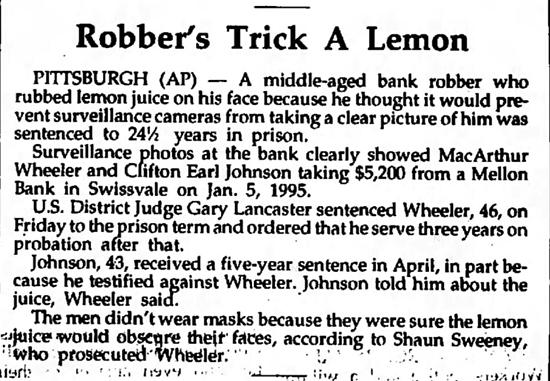
Tyrone Daily Herald - Jan 8, 1996
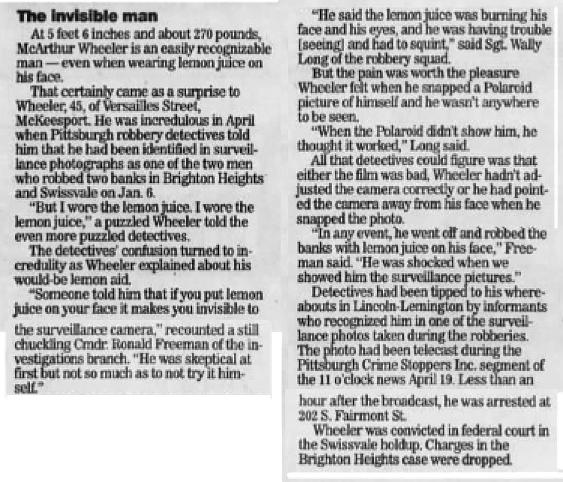
Pittsburgh Post Gazette - Mar 21, 1996
Posted By: Alex - Tue Mar 26, 2019 -
Comments (4)
Category: Stupid Criminals, Psychology, 1990s
The Ratapult
Invented circa 1992 by Allen Gross. It was intended to be a more humane rattrap. Instead of killing the rats, it flung them up to 50 feet into a cage or bucket. The dazed, but still living, rodents could then be either turned over to authorities or released into the wild. Noted Gross, “I didn’t want the (rodents) squashed or turned into meatloaf.”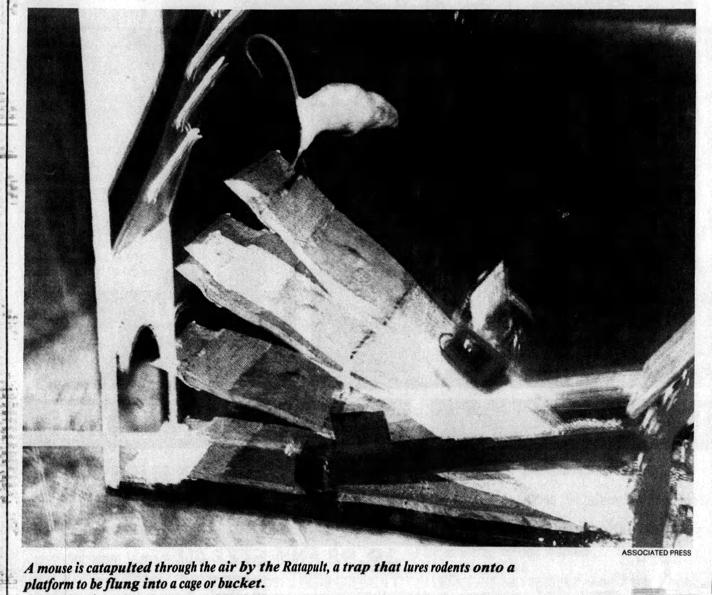
Santa Rosa Press Democrat - Feb 14, 1992
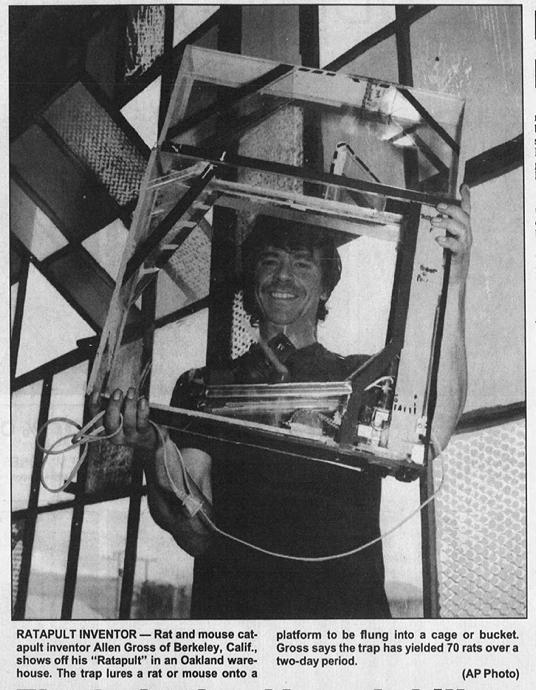
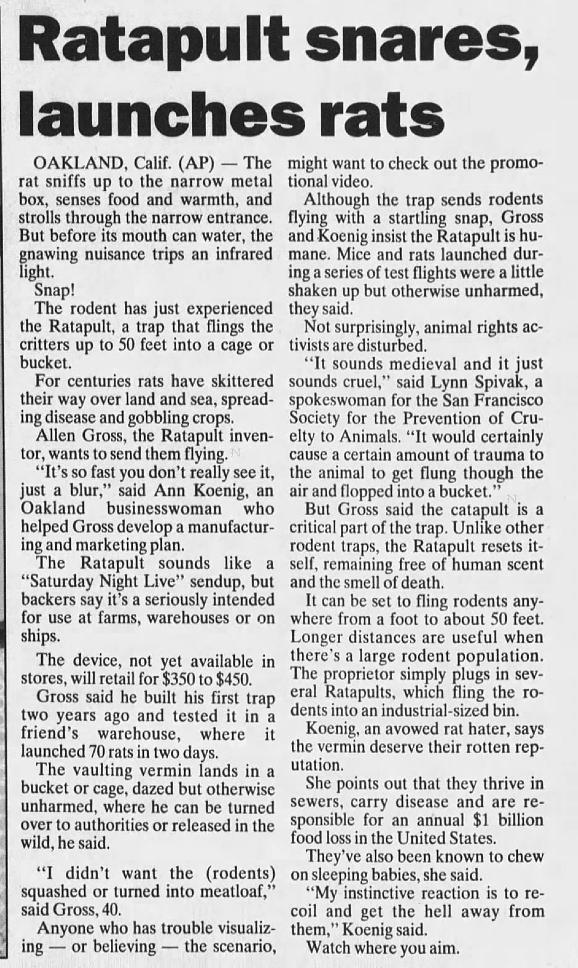
Staunton News Leader - Feb 14, 1992
Turns out this wasn't the first rat-flinging trap to be invented. Back in 1912, a similar device debuted, also called the Ratapult. Though it wasn't intended to be in any way humane:
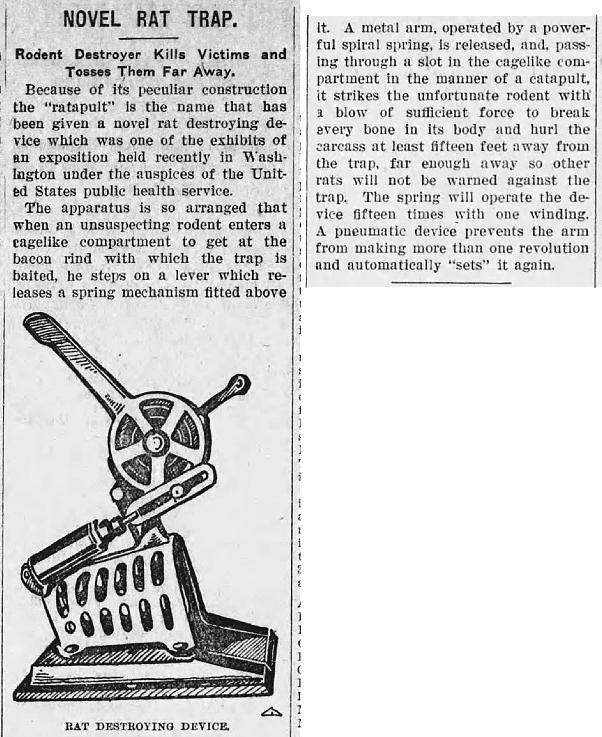
Vergennes Orwell Citizen - Jan 9, 1913
Posted By: Alex - Sat Mar 23, 2019 -
Comments (2)
Category: Inventions, Pests, Plagues and Infestations, 1990s
Hangovers Due to Guilty Conscience
In 1973, Professor Robert Gunn advanced this theory.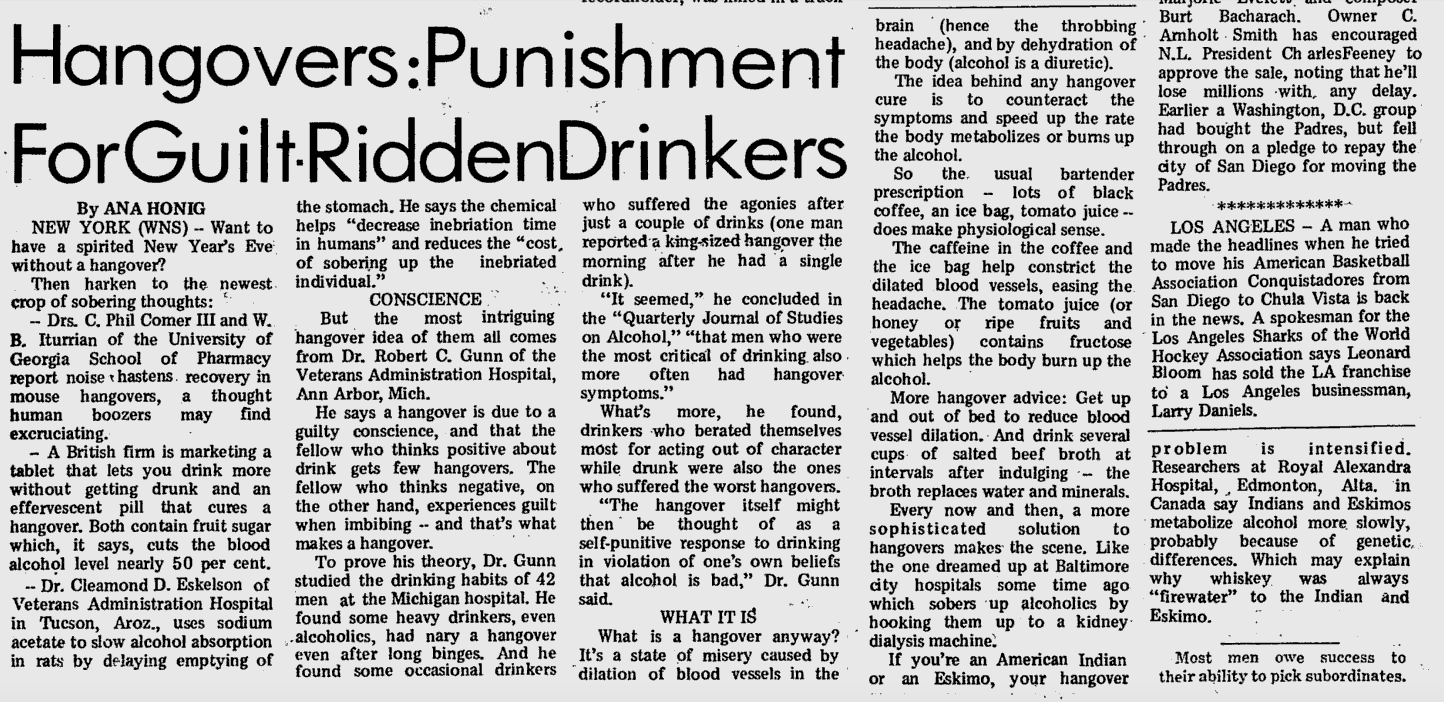
Twenty years later, he was still pursuing the idea, as you can see in the scientific paper at the link.
To reappraise a prior study of hangover signs and psychosocial factors among a sample of current drinkers, we excluded a subgroup termed Sobers, who report "never" being "tipsy, high or drunk." The non-sober current drinkers then formed the sample for this report (N = 1104). About 23% of this group reported no hangover signs regardless of their intake level or gender, and the rest showed no sex differences for any of 8 hangover signs reported. Using multiple regression, including ethanol, age and weight, it was found that psychosocial variables contributed independently in predicting to hangover for both men and women in this order: (1) guilt about drinking; (2) neuroticism; (3) angry or (4) depressed when high/drunk and (5) negative life events. For men only, ethanol intake was also significant; for women only, being younger and reporting first being high/drunk at a relatively earlier age were also predictors of the Hangover Sign Index (HSI). These multiple predictors accounted for 5-10 times more of the hangover variance than alcohol use alone: for men, R = 0.43, R2 = 19%; and for women, R = 0.46, R2 = 21%. The findings suggest that hangover signs are a function of age, sex, ethanol level and psychosocial factors.
Posted By: Paul - Sun Feb 10, 2019 -
Comments (1)
Category: Science, Experiments, Psychology, 1970s, 1990s, Pain, Self-inflicted and Otherwise, Alcohol
The Techno-Bra
Created by Kursty Groves. The bra monitored the wearer’s heartbeat and contacted the police if there was a sudden change indicative of a panic response (suggesting that the wearer was being attacked or in danger). The bra was reportedly going to be manufactured and sold by the British design firm PDD, but as far as I can tell, it never made it to market.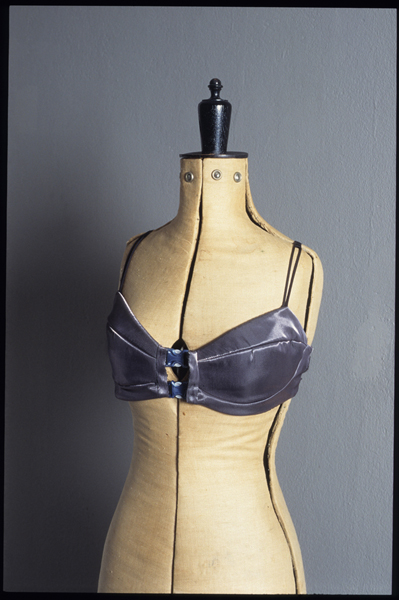
Image source: Visual Arts Data Service

Discover magazine - October 1999
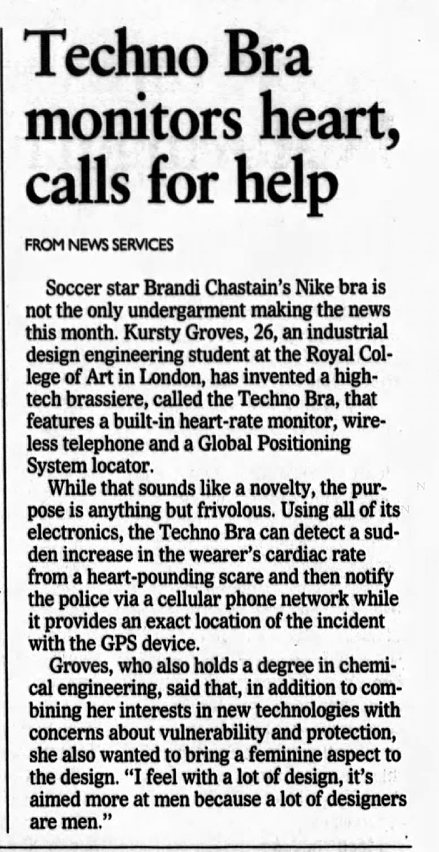
Atlanta Constitution - July 25, 1999
Posted By: Alex - Tue Jan 22, 2019 -
Comments (8)
Category: Fashion, Underwear, 1990s
The rookie rower who failed to cross the Atlantic
Even though he had only been on the ocean once, while taking the Newfoundland ferry, Arthur Russell figured he could row across the Atlantic. He practiced for two years on his rowing machine and then set off from Halifax harbor. Six hours later, he had to signal for help and was rescued.
Edmonton Journal - May 31, 1990
Posted By: Alex - Fri Jan 11, 2019 -
Comments (4)
Category: Boats, Oceans and Maritime Pursuits, Sports, 1990s

| Who We Are |
|---|
| Alex Boese Alex is the creator and curator of the Museum of Hoaxes. He's also the author of various weird, non-fiction, science-themed books such as Elephants on Acid and Psychedelic Apes. Paul Di Filippo Paul has been paid to put weird ideas into fictional form for over thirty years, in his career as a noted science fiction writer. He has recently begun blogging on many curious topics with three fellow writers at The Inferior 4+1. Contact Us |




